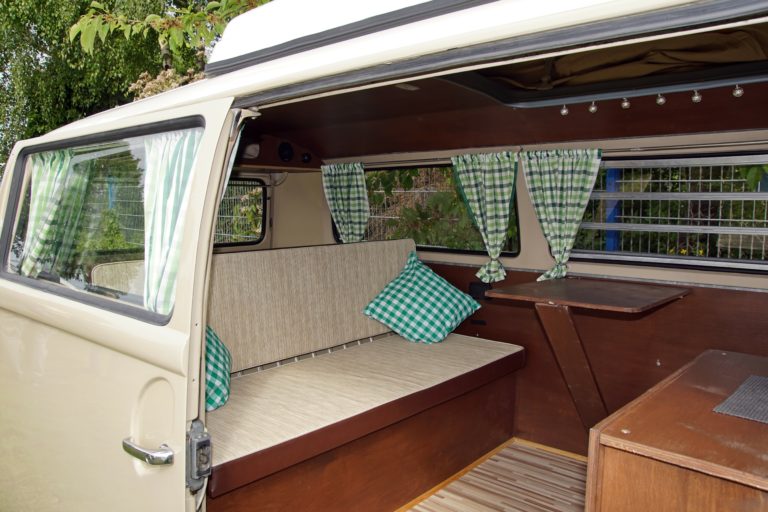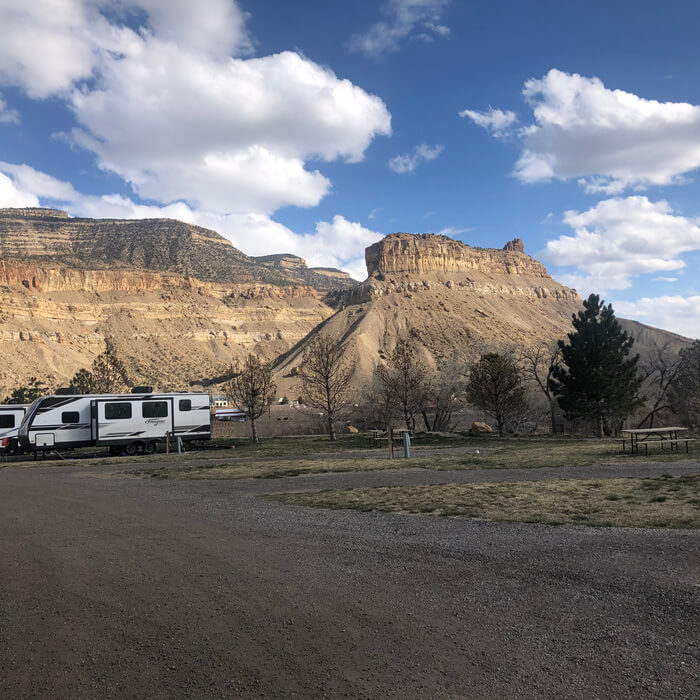15 Expert Tips: How To Drive An RV In High Winds
NOTE*** The content on this page may contain affiliate links, we may make a commission. And, as an Amazon Associate, we earn from qualifying purchases. More information: disclosure page.
Knowing how to drive a recreational vehicle in high winds is probably the last thing that newbies will think of. However, if you are going to ask an experienced RVer, they will tell you that this is something that every RVers should know considering you are driving a high-profile vehicle that can easily get affected by crosswinds.
In general, driving in an RV with winds that are more than 40 MPH (miles per hour) and gusting 60 MPH is dangerous. Longer and taller RVs and trucks towing a trailer increase the risk of an accident due to the wind. Driving with the wind is safer than driving in crosswinds.
Driving in high winds can be dangerous! Due to the shape of an RV, it acts as a sail and catches the wind from the side. You can lose control and be pushed off the road or the trailer can sway. Even worse, a wind gust could catch the side of your rig and overturn the whole thing.
As an RVer myself, I know that getting caught by extreme weather conditions such as high winds while you’re on the road sometimes happens. Therefore, you must know what you have to do in case you will be in that situation.
With that being said, this article will help you answer the most common questions that you may have if you want to know how to drive an RV in high wind.
I’ll also share with you a few things that you have to consider before going on a trip in high wind weather and I’ll give you 15 expert tips that you should know whether you are driving on the road or stationary in an RV.
15 Tips to Drive an RV in High Winds
1. Drive Slowly
Driving slowly can keep you and the other vehicle safe when there is high wind. Because when you are driving fast, you don’t have much control over your vehicle and you have less time to act when anything happens.
Just one sudden burst of wind is enough to make heavy vehicles lose control. If you are driving fast, then it is harder to gain back control after the gust of wind.
2. Drive directly to the wind
Another way to keep safe from high winds while driving an RV is to drive directly to the wind. This helps you not to get tipped over but make sure to still drive slowly.
Driving directly towards the wind prevents being pushed by it. Just like swimming towards the current, the wind will divide and pass on the sides, instead of getting ahold of one of the sides of your vehicle and tipping you over.
3. Look for the nearest exit
If you are on a highway and the winds start to get crazy, start looking for the nearest exit where you can pull off. It’s always better to stop driving in this kind of situation.
In case you are in the middle of the highway and far from the next exit, stop on the shoulder of the road. Make sure to be wary of incoming vehicles and that no trees and powerline are near where you will stop. Stay inside your vehicle and put your hazard lights on.
4. Hide in a safe place
If you can stop and pull off the road, look for a place where you can hide from the wind. It can be tall buildings or underpasses. These are the perfect places to hide from high winds.
On the other hand, if you are not able to stop. Be ready for sudden wind spikes when passing by buildings and bridges, which can cover you from the wind but can throw you off course when you pass by them.
5. Check the weather before hitting the road
It is a good practice to always check and keep track of the weather condition while you are out to make sure you are going to be prepared for anything that can happen.
If the date of your travel cannot be moved, try to plan your route where you will pass by open areas less.
6. Be sure that your slides are pulled in
When there’s a high wind and you are stationary, you have to make sure that your RV slides are in. Having your slides out can be dangerous to you and can also cause damage to your RV.
7. Put all the weight at the center of your RV
By putting all the weight at the center of your rig, you are keeping the balance and you will be less likely to be tipped or swayed by the high wind.
Tie everything down. I cannot stress how important this is. Things tend to move a lot in normal travel speed, what more when additional wind gusts are moving the RV. Keep all things in the middle of the RV to avoid tipping when unbalanced.
8. Remove all your gears outside
If you are stationary and a high wind suddenly comes, make sure to remove all the gears outside your rig. It can be tables and chairs or solar panels.
Do a one-round sweep on all sides and close all windows, awnings, roof, and anywhere water and wind can seep in.
9. Close your bays
Make sure your storage bays and propane basement are latched and closed. Your basement is full of important equipment for your rigs, so you have to make sure that this is safe during high winds.
10. Close your RV roofs and windows
Always close your RV roof vents and windows or else, your rig is going to be full of dirt and dust. Most especially if you are on a mountain dessert.
If you are expecting rain and wind, make sure the enclosures are airtight shut.
For more roof articles, read these:
11. Hook up your tow vehicle
Hook up your tow vehicle to your trailer. By doing this, you are adding an extra weight anchor that helps your trailer not to get swayed and be more secured.
To read more about towing, click this:
12. Fill your water tanks
Filling your Water tanks can also help put more weight on your RV. So it will be best to fill your freshwater, greywater, and even your black water tanks.
On average, RV water tanks add up to 20-100 gallons of liquid weight.
More reading:
- 11 Smart Pop-up Camper Gray Water Tank Ideas
- Where to Empty RV Black Water Tank? (+instructions and cost)
13. Crank in your awning
Don’t forget to crank in your RV awning. Many new RVers are learning it the hard way and not doing it when the high wind hits.
More reading:
14. Check your RV roof
This is something that you should do regularly and not just during high winds. Do a regular check on your roof to make sure that the screws and joints are attached right and tight.
More reading:
15. Check your surroundings
This is applicable when you are both driving an RV or stationary. You must check and be aware of anything that could fall on your RV roof like tree branches or debris.
As a precaution, check with your insurance about the kinds of damages that they cover. Once you know these damages, you will have a clear list on your mind of what to check before calamities.
Which Type of RV Is Safest to Drive in High Winds

Generally speaking, your safety while driving in high winds depends on both on which type of RV or trailer you drive and how you drive. RVs and trailers come in different shapes and sizes. But mostly, the bigger types of RVs are more prone to getting tipped over when being driven in high winds. Especially if you are driving too fast! Slow down.
Large RVs have more surface area so it is more likely to get tipped over by a wind gust.
While trailers, on the other hand, are more prone to getting swayed when a wind gust starts to push the trailer’s broadside. Once the trailer begins to sway, you, the driver can lose control of your vehicle.
5 Things That You Need to Consider Before Going on a Trip in High Winds

- Is it an important trip or can it be rescheduled?
If the wind is in the forecast on the day of your planned trip, just postpone it if it is not that important. Your safety is more important than anything else.
Sometimes waiting till a little later in the day will be enough for the wind to doe down.
- Consider the shape and weight of your RV and Tow Vehicle
Just like a semi-truck the combination of the shape of the RV and the weight will determine how much the wind affects the movement. The sail effect of the big box of a motorhome or trailer will be even more noticeable with a light load.
You don’t need to go and add a bunch of weight but pack your gear correctly. Distribute your belongings inside the RV so the weight is distributed.
- Check if one of your routes has a wind restriction
Some areas do not allow high-profile vehicles at a specific wind speed. So make sure to check with the local regulations during high wind weather before you hit the road. This will help you avoid any delays and be at your destination on time.
- Choose a route that is safe to take during high winds
If your original routes are those that have scenic views and mountains, look for an alternative route where you will be safe from falling trees and high places where you might fall once your rig starts to be uncontrollable.
- Don’t drive tired.
Every driver is individual and not everyone is comfortable driving an RV in extreme wind conditions. If you feel this way, it is better to stay where you are for now. Alertness is one of the most important things you need if you are driving. Especially in high winds.
Important Related Questions
What Wind Speed Is Dangerous for RVs?
In general, 60 mph is already dangerous when you are driving an RV. That is why it is always advisable to close up, drive slower and pay attention when the wind is already at 40-60mph.
How Fast Should You Drive a Camper in High Winds?
Generally, driving below the 10-20 mph speed limit is recommended if you are driving in high winds. Although there’s no specific speed limit to drive in this weather condition because it will still depend on the driver’s comfortability. But of course, the slower the better.
What to Do If a Trailer Starts to Sway While You’re on the Road?
When a trailer starts to sway while you’re on the road it is best to activate the manual brake control override by hand. Furthermore, make sure that you keep a firm grip on the steering wheel. This will help you control the sway caused by the high winds.
Can a Camper Tip over in the Wind?
Camper trailers can indeed tip over in a wind. This can happen if you are fishtailing and taking corners too fast especially in windy weather.

Final Thoughts in Driving an RV in High Winds
To sum things up, if you are planning to go on a trip or you are about to leave the campground and a high wind suddenly hits, it is always better to postpone it. You can always reschedule your trip and paying an extra day in a campground is much better than risking your safety.
Otherwise, if it hits while you are on the road, take the safety tips that I shared above and be extra careful and alert while driving. If you can pull off the road, then do so and wait till the wind calms before you start driving again.
Just remember, whatever weather it may be, think of yourself, and the other vehicles’ safety all the time.

Hi, I’m Shauna – Welcome to Family Travel Fever. We are a large family, that was bitten by the travel bug! I take the kids by myself because I don’t mind flying or driving solo with my crew to discover the coolest places.
Sign up for our email list for my best travel tips plus get the family travel planner free.
[/et_pb_text][/et_pb_column]
[/et_pb_row]
[/et_pb_section]






